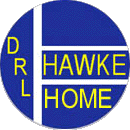

| Model | Year | Class | Production | Designer | Comments |
| DL1 | 1968 | FF1600 | 1 | David Lazenby | Prototype FF |
| DL2 DL2A DL2B |
1969 1970 1971 |
FF1600 FF1600 FF1600 |
28 54 27 |
David Lazenby | Production Version of the DL-1 |
| DL5 | 1971 | FSV | ? | ? | Air-cooled Super Vee |
| DL6 DL6A |
1971 1971 |
FA FB |
? | David Lazenby | Appeared in both FA and FB trim |
| DL7 | 1971 | F5000 | 1 | Len Terry | Built as a Leda LT22, purchased by Lazenby and re-branded as a Hawke DL7. |
| DL8 | 1971-1972 | FSV | ? | ? | ? |
| DL9 | 1972 | FF1600 | ~30 | David Lazenby | John Bicht came on in early 1972, and McKinstry was at the shop and sponsoring Syd. |
| DL10 | 1972-1973 | FF1600 | Probably 25 | David Lazenby | The DL10 was an entirely new design, although the general style of the frame remained the same as the DL9. Many small improvements were made such as the gear change mechanism. The body was a joint design between David and John Bicht. David wanted side radiators because of the amount of bashing and crashing that went on in English FF. John wanted the rear engine cover because he really liked the look of the Ensign F3 cars. The suspension was modified considerably over the winter on the car called "DL10 prototype". The DL10 wasn't successful. |
| DL11 | 1973-1974 | FF1600 | 30 | David Lazenby | DL11's were made in 73 and 74, and many were converted from DL10's. Any DL10 in England was converted. This car was a development project by David and John. John's car was the test mule, and everything was tried. This car went out nearly every Wednesday or Thursday from late March to late October. (By the way, if John's car still exists, it can be identified by the Lotus 69 style gear change mechanism, the oil filter under the transmission, and something different about the dashboard. Also, the mount for the top link of the rear suspension was just a plate bolted to the DL10 mounting point.) |
| DL12 | 1974-1975 | FF1600 | ? | David Lazenby | "Super Slipstreamer" |
| DL14 DL14B |
1975-1976 1976 |
FF2000 F3 |
? | ? | A DL14 chassis was re-engined with a 2 litre BDA engine and run in F3 in 1975, 76 & 78. |
| DL15 | 1976 | FF1600 | 65 | Adrian Reynard Engine Bay | - |
| DL16 | 1976-1977 | FF2000 | ? | ? | - |
| DL17 | 1977 | FF1600 | ? | David Lazenby | Long Engine/gearbox spacers Conventional layout |
| DL18 | 1977 | F3 | 3 | Adrian Renard | Cars driven by Rupert Keegan, Jan Lammers, and the third car never raced? |
| DL19 | 1978 | FF1600 | ? | ? | - |
| DL20F | 1978 | FF1600 | ? | ? | - |
| DL20SF | 1979 | FF2000 | ? | ? | - |
| DL22 | 1978 | FF2000 | 4 | ? | This car was a DL19 chassis with inboard front shockers and roller rocker suspension. |
Notes from John Bicht:
Several things should be pointed out to restorers of DL9 through 11. These are things that could cause potentially very dangerous conditions while on the track.
In the middle of 72 the front lower wishbone was changed so that the connecting link between the front and rear inner rod end was removed. This to clear the 9 body which bulged considerably. This caused the wishbone to be no longer triangulated and failure can occur where the tube from the rear inner rod end first joins the rest of the welded structure. This design persisted until late in 73 when the failure happened to me on the DL11. The design was then modified. The failure may occur more on TIG welded wishbones - probably started in 73 - than on the earlier nickel bronze welded units. I can provide additional info if desired.
Front and rear live axles. There was a period where these were made with insufficient radius where the outer bearing boss (that ground portion of the axle that the outer bearing is pressed onto) meets the axle flange (also a ground area but flat, the bearing is pressed on until it hits this flat). There was for quite a long time almost no radius here. The flange breaks off the axle, and usually the wheel leaves the car. It happened to many of us. I am certain this was during DL9 days and I think the fix occured then. Finally a very generous radius, around 1/8", was used. We would place the bearings in the lathe and machine a chamfer in the inner race to clear the radius. I would not drive any car built prior to the DL11 (late 73) without checking the axles for this radius.
I think that all US racing groups require capture washers over rod ends used with a single shear bolt. The problem was that the English didn't and so nothing was put on the outside rear rod end (parallel link meets the upright). Disaster.
Last Updated on 28 February, 2013
By Brian Gent

